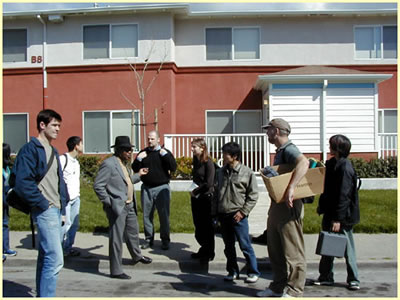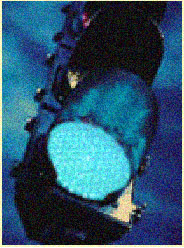|
Energy-efficient technologies don't start saving money and reducing energy
consumption until people start using them. The research and development
of new technologies isn't complete until they are put into practice.
That's where the Department of Energy's Rebuild America program comes
in, with the help of Lawrence Berkeley National Laboratory's scientists
and consultants, among others. Rebuild America helps communities create
partnerships to make energy-efficiency improvements that help save money
and revitalize buildings.
Rebuild America focuses on five areas -- schools; colleges and universities;
state and local governments; public and multi-family housing; and commercial
buildings -- and the program has more than 500 community partners in every
state of the union.
Between 1995 and 2002 DOE invested $51.5 million in the program, resulting
in the renovation of more than 500 million square feet of building space;
additional projects amounting to 570 million square feet have been committed
or are underway. Rebuild America estimates that its work is saving $131
million dollars annually in energy costs (9 trillion BTUs); through the
end of 2002, the program leveraged a capital investment of $600 million.
When Rebuild America representatives encounter questions that require
more in-depth technical assistance than they can provide, they refer partners
to expertise in DOE's national laboratory system. Most technical assistance
is provided by Rebuild's business partners and by three national labs:
Pacific Northwest, Oak Ridge, and by the Environmental Energy Technologies
Division (EETD) at Berkeley Lab.
Rick Diamond, a scientist in EETD, who manages the Rebuild America Program
at the Lab, spends a considerable amount of time working to help communities
that need technical assistance on energy-efficient retrofits. Barely a
week goes by when he isn't working on one Rebuild America request or another.
"Today I've been working with the City of East Palo Alto, California,
to identify bulletproof, energy-efficient street lighting fixtures,"
Diamond said recently. The previous week, he'd been facilitating a workshop
on energy-efficient multifamily housing in Kansas City, Missouri.
"We respond to about 50 to 60 calls per year for design assistance
referred to us from Rebuild," says Diamond. "The help we provide
can range from a simple telephone call, to referrals to papers, web sites
and design guides, to teaching design workshops, to spending a week or
two working with a design team planning a retrofit project."
Usually requests are assigned to specific labs by geography or because
of special expertise. Diamond's Berkeley Lab colleagues have helped Rebuild
America bring energy-efficient design to major public buildings, schools,
and housing projects; have reviewed specifications for energy-efficient
systems in public buildings; and have taught workshops on energy-efficient
design for the public, community officials, and architects.
Diamond adds that design assistance includes "helping the client
understand what kind of savings it is possible to achieve through energy
efficiency in their project, and acting as a resource to the design team,
helping them use energy modeling programs, for example."
Diamond counts 24 people in EETD or Berkeley Lab's Facilities Department
who have worked on Rebuild technical assistance or related projects recently,
including Hashem Akbari, Dariush Arasteh, Doug Avery, Owen Bailey, Vlado
Bazjanac, Allan Chen, Rick Diamond, Liz Exter, Chuck Goldman Steve Greenberg,
Nicole Hopper, Judy Jennings, Saki Kinney, Jim Lutz, Nance Matson, Laura
McLaughlin, Evan Mills, Erik Page, Mary Ann Piette, Francis Rubinstein,
Dale Sartor, Michael Siminovitch, Haider Taha, and Charles Williams.
Here are a few of the Rebuild America projects to which Berkeley Lab
staff has lent a hand:
Rehabilitating the Oakland Housing Authority's multifamily
housing
The Oakland Housing Authority (OHA) provides housing for low-income
residents of this California city. More than 48,000 residents live in
OHA-owned units, or in units supported by rental assistance.
|
 |
|
| Oakland Housing Authority
architect David Brown shows Rick Diamond (right, in cap) and his UC
Berkeley architecture students the newly renovated public housing
at Lockwood Gardens, Oakland, California. Photo: Judy Monnier, OHA. |
|
"We have been providing design specifications for improving the
energy efficiency of ventilation and of HVAC systems to OHA for the rehabilitation
of old units," says Diamond. (HVAC stands for heating, ventilation,
and air conditioning.) This has been an ongoing project for several years.
In 2002, OHA won Rebuild America's Energy Champion Award for Partnership
of the Year -- recognized for its progress in saving energy and money
by making energy efficiency improvements in 242 of its 267 sites. More
than 2,290 units at 18 sites received energy-efficiency improvements in
common areas, like new fluorescent lighting, energy-efficient boilers,
and Energy Star® washing machines and dryers. The total annual utility
savings is expected to be about $362,000.
Helping cities and states with energy-efficient
lighting
Energy-efficient lighting is often at the top of the list in retrofit
projects. Berkeley Lab staff has assisted cities with a great variety
of lighting projects. Berkeley Lab researcher Judy Jennings responded
to a request from Rebuild Hawaii about occupancy sensors.
"Their question was whether occupancy sensors reduced the life of
energy-efficient compact fluorescent lamps. I put together a brief study
and a spreadsheet for them answering the question." Says Jennings,
"Occupancy sensors help save so much money on lighting energy that
the effect overwhelms other factors, such as a slight decrease in lamp
life."
Traffic lights provide another opportunity for cities to save money,
reducing energy use as well as maintenance costs. Owen Bailey, a graduate
student who is working with the Environmental Energy Technologies Division
and who spent summer 2002 at the Lab, is helping the City of San Antonio,
Texas, evaluate the economics of installing solid-state traffic lights
based on LEDs (light-emitting diodes). In addition to using much less
energy, these lights are longer-lived than incandescent models, saving
substantially on maintenance costs.
|
|
 |
 |
|
|
| |
Traffic lights using LEDs instead
of incandescent bulbs repay their higher initial costs with lower
energy costs and fewer bulb replacements. |
|
|
"San Antonio was looking for a review of their financial analysis
and an estimate of the payback period, or some other financial measure,"
says Bailey, currently a graduate student at Cornell University's Environmental
Systems Group, in the Civil and Environmental Engineering Department.
"I prepared a payback spreadsheet calculator to allow them to insert
their own estimates of certain values, such as components of the electricity
tariffs and the labor costs involved with traffic signal maintenance.
The payback period would then be updated based on the input values they
selected."
Bailey also set up a spreadsheet to compute the net present value of
the project (a financial measure of all the future savings from the lights,
as though they were accrued immediately), phasing in LED signals over
five years for all intersections, and calculating benefits over 14 years.
The minimum savings he calculated, at three percent interest, was $2.4
million. "As a finance professor said," Bailey notes, "doing
the project is like finding $2.4 million under a rock."
Rebuild America, part 2
|

